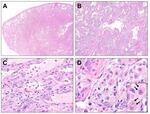Researchers looking into what’s injuring people who vape have been focused on oil coating the lungs, a form of pneumonia. Now another problem is surfacing: lungs that look like they’ve been chemically burned.
A recent study in the New England Journal of Medicine looked at 17 lung biopsies from serious vaping illnesses around the country. They all showed injuries associated with exposure to toxic chemicals like a worker who inhaled fumes at a chemical spill, or a soldier exposed to mustard gas.

Histology in fatal cases of vaping-associated acute lung injury. Representative photomicrographs of surgical lung biopsies from a 31-year-old woman (Case 5) with vaping-associated acute lung injury that culminated in her death. (A) At scanning magnification, the process is quite diffuse, but still vaguely accentuated in centrilobular regions. (B) Closer examination reveals characteristic features of diffuse alveolar damage in a subacute, organizing phase with well-formed hyaline membranes lining respiratory bronchioles and alveolar ducts. (C) At higher magnification, striking vacuolization and reactive atypia of pneumocytes is apparent, with edematous alveolar septa and scattered inflammatory cells including a few neutrophils and rare eosinophils. (D) In centrilobular regions, abundant macrophages filled airspaces and were intimately admixed with proliferating fibroblasts and organization. Most macrophages were foamy, but scattered individual macrophages contained light brown pigmented particles (inset, arrows).
New England Journal of Medicine
Doctor Cathy Markin with Legacy Good Samaritan Hospital in Portland said the different illnesses hint at different causes.
“And that’s why this investigation is so complex," Markin said. "Because it’s probably not just one thing about the vaping, or one factor about the person who vapes, that puts them at risk.”
Markin published an article eight years ago about a woman who vaped and suffered from pneumonia, long before the recent series of vape-related illnesses.
The Centers for Disease Control and Prevention now said it's seen 1,299 confirmed and probable lung injury cases across 49 states, the District of Columbia and the U.S. Virgin Islands. It also reported 29 deaths.
